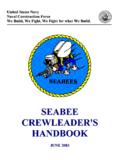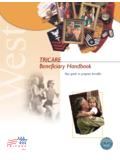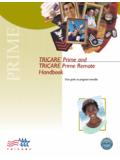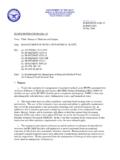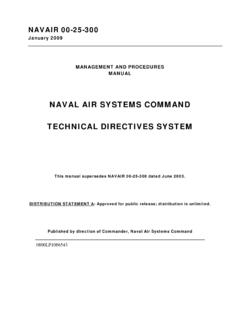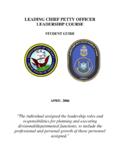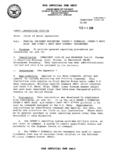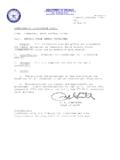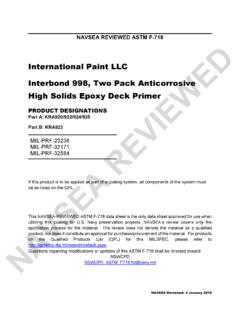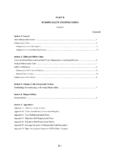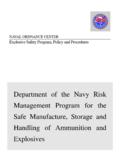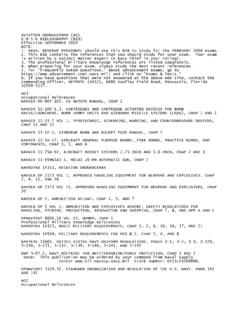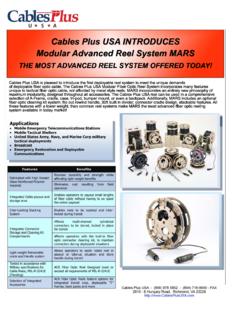Transcription of This page left intentionally blank - NAVY BMR
1 this page left intentionally blank navsea OP 3565/NAVAIR 16-1-529 VOLUME 2 SEVENTEENTH REVISIONTECHNICAL MANUALELECTROMAGNETIC RADIATION HAZARDS (U)(HAZARDS TO ORDNANCE) (U)DISTRIBUTION STATEMENT AApproved for Public Release; Distribution is Unlimited. this PUBLICATION SUPERSEDES navsea OP 3565/NAVAIR 16-1-529/NAVELEX 0967-LP-624-6010 VOLUME 2 SIXTEENTH REVISION DATED 1 JUNE 2007 PUBLISHED BY DIRECTION OF COMMANDER, NAVAL SEA SYSTEMS COMMANDThis page left intentionally blank navsea OP 3565/NAVAIR 16-1-529 VOLUME 2 SEVENTEENTH REVISIONTECHNICAL MANUALELECTROMAGNETIC RADIATION HAZARDS (U)(HAZARDS TO ORDNANCE) (U)DISTRIBUTION STATEMENT AApproved for Public Release; Distribution is PUBLICATION SUPERSEDES navsea OP 3565/NAVAIR 16-1-529/NAVELEX 0967-LP-624-6010 VOLUME 2 SIXTEENTH REVISION DATED 1 JUNE 2007 PUBLISHED BY DIRECTION OF COMMANDER, NAVAL SEA SYSTEMS COMMAND1 JULY 2008 navsea OP 3565/NAVAIR 16-1-529 VOLUME 2 SEVENTEENTH REVISIONAR eproduction for nonmilitary use of the information or illustrations contained in this publication is not permitted.
2 this does not preclude reproduction and use of any part of this manual by contracted agencies responsible for the training and instruction of personnel who handle and transport military ammunition, explosives, and related hazardous materials. The policy for military use reproduction is established for the Army in AR 380-5, for the Navy and Marine Corps in SECNAVINST (series), and for the Air Force in Air Force Regulations OF EFFECTIVE PAGESThe total number of pages in this manual is 156. They are all original Revision Seventeen pages . The date of issue for all pages in this manual is 1 July page left intentionally blankForeword-1/(Foreword-2 blank ) navsea OP 3565/NAVAIR 16-1-529 VOLUME 2 SEVENTEENTH REVISIONFOREWORD1. The purpose of this volume is to prescribe operating procedures and precautions to prevent initiation of electrically initiated devices (EID s) in ordnance from electromagnetic radiation (EMR).
3 2. this manual supersedes navsea OP 3565/NAVAIR 16-1-529 Volume 2 Sixteenth Revision, dated 1 June 2007, which should be this volume provides technical guidance to assist commanding officers in carrying out their responsibilities for safety from a radio frequency hazards standpoint. The procedures and precautions prescribed herein apply in every instance within the Naval establishment (ships and shore stations) where an electrically-initiated explosive item is exposed to radio frequency fields of potentially hazardous frequency and intensity. Operational commanders may waive compliance with any provision, when essential, under emergency conditions. When noncompliance with restrictions contained herein is essential, emergency procedures are provided in order to explain and minimize the risks Changes and revisions to this publications will be promulgated by Commanding Officer, Naval Ordnance Safety and Security Activity (NOSSA) in a timely manner following coordination with other cognizant commanders such as NAVAIRSYSCOM for air launched weapons and current aircraft, and SPAWARSYSCOM for transmitter radio frequency (RF) emission data.
4 Interim changes will be made by letter or message as ACN s (advance change notices) which will be directed to the commanders directly concerned. Comments or suggestions relative to material to be included in such changes should be forwarded as specified in the following Ships, training activities, supply points, depots, Naval shipyards, and supervisors of shipbuilding are requested to arrange for the maximum practical use and evaluation of navsea technical manuals. All errors, omissions, discrepancies, and suggestions for improvement to navsea technical manuals shall be reported to the Commander, Naval Surface Warfare Center, Port Hueneme Division (NSWC/PHD) (Code 310), 4363 Missile Way, Port Hueneme, CA 93043-4307 on navsea Technical Manual Deficiency/Evaluation Report (TMDER), navsea Form 4160/1.
5 A copy of navsea TMDER Form 4160/1 is included at the end of this publication. For activities with internet access, this form may also be completed and processed using NSWC/PHD website: To expedite a response, also send as an email to When using this website, the correct publication number to use to generate a TMDER against this manual is OP03565 (4 spaces) 02001700. All feedback comments shall be thoroughly investigated and originators will be advised of TMDER resolution. If you prefer to submit a TMDER using a word file, click page left intentionally blankNAVSEA OP 3565/NAVAIR 16-1-529 VOLUME 2 SEVENTEENTH REVISIONiChapter/ParagraphPageTABLE OF CONTENTSList of Figures .. ivList of vSafety Summary .. viCHAPTER 1 1-11-1. Purpose.
6 1-11-2. Scope .. 1-11-3. Background .. The Need for HERO Control.. 1-41-4. Introduction to HERO Classification .. 1-51-5. Managing HERO .. Assessment of Risk.. Navy-Unique Classifications.. 1-61-6. Tri-Service Approach to HERO .. Common Approaches.. DOD-Wide Application.. 1-71-7. Personnel Requirements .. Training.. Safety 1-81-8. HERO Warning Symbols and Labels .. HERO Warning Symbols.. HERO Warning Ordering HERO Warning Symbols and 1-111-9. Definitions, Abbreviations, and Symbols .. 1-111-10. Reference Documents .. 1-111-11. Date of Publication .. 1-121-12. HERO Data Sheet Profile Tool .. 1-12 CHAPTER 2 RF ENVIRONMENTS.
7 2-12-1. Methods for Controlling the RF Environment .. Peak and Average Power Antenna Field Power Density and Field Intensity Calculations.. 2-32-2. Field Strength/Distance Restrictions .. Safe Field Strength/Distance Calculation .. Relaxation of 10-Foot Rule.. Multiple Superimposed Field Calculations.. 2-72-3. Control of RF Environments .. Control of RF Environments for HERO SUSCEPTIBLE, HERO UNSAFE, and HERO UNRELIABLE Notification of Transfer of Other Than HERO SAFE ORDNANCE.. 2-8 navsea OP 3565/NAVAIR 16-1-529 VOLUME 2 SEVENTEENTH REVISIONiiChapter/ParagraphPageTABLE OF CONTENTS (Continued)CHAPTER 3 USE OF RF EMITTERS IN PROXIMITY TO ORDNANCE .. 3-13-1. Introduction .. Exceptions to 10-foot 3-13-2.
8 Installation of New Emitter System or Sources of RF Emissions on Shore Facilities .. 3-23-3. Electrical and Electronic Devices in Ordnance Areas .. Private and Amateur Automatic Identification Technology (AIT).. Laptop and Desktop Computers.. Unexploded Ordnance (UXO) Detection Equipment.. X-Raying of Ordnance.. 3-4 CHAPTER 4 GUIDANCE FOR MANAGING HERO DURING NATO 4-14-1. Introduction .. NATO RADHAZ.. Ordnance SRAD Emitter TRAD Codes.. AECP-2 RADHAZ U. S. Navy EMCON Navy Modified AECP-2/EMCON Procedures.. 4-5 CHAPTER 5 HERO EMISSION CONTROL (EMCON) BILL .. 5-15-1. General .. 5-15-2. HERO EMCON Bill Development .. Emitter Ordnance List and Location Compare Safe Separation Distances from Ordnance Locations.
9 Generation of HERO EMCON Bill.. 5-105-3. HERO EMCON Bill Update or Modification .. New Ordnance Items.. New Emitter Systems.. 5-135-4. HERO EMCON Bill Worksheet .. 5-135-5. Joint Operations or Exercises HERO Guidance .. 5-14 CHAPTER 6 HERO SURVEY .. 6-16-1. General .. When to Request a Shipboard HERO Survey.. HERO Survey Teams.. HERO Shore Survey Periodicity The HERO Survey Process.. 6-36-2. Request .. 6-36-3. Pre-Survey Requirements .. 6-3 navsea OP 3565/NAVAIR 16-1-529 VOLUME 2 SEVENTEENTH REVISIONiiiChapter/ParagraphPageTABLE OF CONTENTS (Continued)6-4. Procedures .. Measurement of EME.. Report.. Sample HERO Instructions.
10 6-10 CHAPTER 7 HERO REQUIREMENTS DURING ORDNANCE OPERATIONS .. 7-17-1. Introduction .. 7-17-2. Ordnance HERO Classifications .. How to Determine HERO How to Use HERO Data.. HERO UNSAFE or HERO UNRELIABLE ORDNANCE.. Components of All-Up Rounds (AUR S).. 7-47-3. General HERO Requirements .. General HERO Requirements for Ordnance HERO Requirements for Transportation of Ordnance on Shore Stations.. HERO Requirements for Shipboard Ordnance Operations.. 7-8 APPENDIX A DEFINITIONS AND ABBREVIATIONS .. 1-1A-1. INTRODUCTION .. 1-1A-2. DEFINITIONS .. 1-1A-3. ABBREVIATIONS .. 1-7A-4. SYMBOLS .. 1-21 APPENDIX B REFERENCE DOCUMENTS .. 2-1 APPENDIX C HERO EMISSION CONTROL BILL C-1 APPENDIX D SAMPLE HAZARDS OF ELECTROMAGNETIC RADIATION TOORDNANCE INSTRUCTIONS FOR SHIPS AND SHORE D-1 APPENDIX E HERO SURVEY PERIODICITY CHART.
